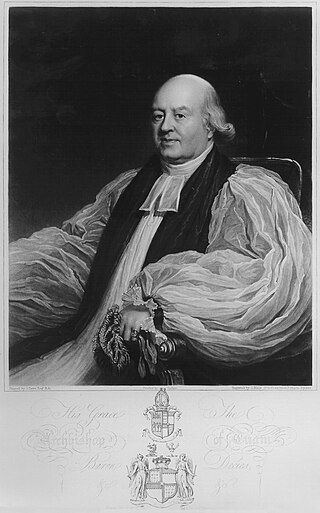Related Research Articles
Duke of Buckingham, referring to Buckingham, is an extinct title that has been created several times in the peerages of England, Great Britain, and the United Kingdom. There were creations of double dukedoms of Buckingham and Normanby and of Buckingham and Chandos. The last holder of the dukedom died in 1889.
The Peerage of the United Kingdom is one of the five Peerages in the United Kingdom. It comprises most peerages created in the United Kingdom of Great Britain and Ireland after the Acts of Union in 1801, when it replaced the Peerage of Great Britain. New peers continued to be created in the Peerage of Ireland until 1898.

Marquess of the County of Bute, shortened in general usage to Marquess of Bute, is a title in the Peerage of Great Britain. It was created in 1796 for John Stuart, 4th Earl of Bute.

Marquess of Waterford is a title in the Peerage of Ireland and the premier marquessate in that peerage. It was created in 1789 for the Anglo-Irish politician George Beresford, 2nd Earl of Tyrone. The title is presently held by Henry Beresford, 9th Marquess of Waterford.

Earl of the Island of Jersey, usually shortened to Earl of Jersey, is a title in the Peerage of England. It is held by a branch of the Villiers family, which since 1819 has been the Child Villiers family.

Earl of Dumfries is a title in the Peerage of Scotland. It was originally created for William Crichton, 9th Lord Crichton of Sanquhar, in 1633, and stayed in the Crichton family until the death of the fourth countess in 1742, at which point the title passed to first the Dalrymple and then the MacDouall families before finally being inherited by the Marquesses of Bute, where it remains today.

Earl of Stair is a title in the Peerage of Scotland. It was created in 1703 for the lawyer and statesman John Dalrymple, 2nd Viscount of Stair.

Earl of Wharncliffe, in the West Riding of the County of York, is a title in the Peerage of the United Kingdom.
This is a list of people who served as Lord Lieutenant of County Waterford.

John Stuart, 1st Marquess of Bute PC, FRS, styled Lord Mount Stuart until 1792 and known as The Earl of Bute between 1792 and 1794, was a British nobleman, coalfield owner, diplomat and politician who sat in the House of Commons from 1766 to 1776.

Rear Admiral John Townshend, 4th Marquess Townshend, known as John Townshend until 1855, was a British nobleman, peer, politician, and naval commander.

George de la Poer Beresford, 1st Marquess of Waterford, KP, PC (Ire) was an Irish politician, known as George Beresford, 2nd Earl of Tyrone from 1763 to 1789.

William Beresford, 1st Baron Decies was an Anglo-Irish clergyman.
Henry Windsor Villiers-Stuart, was a British soldier, clergyman, politician, Egyptologist, and author.

Clan Stuart of Bute is a Highland Scottish Clan and is a branch of the larger Clan Stewart.
Henry Villiers-Stuart, 1st Baron Stuart de Decies PC, was a British politician.
Katherine FitzGerald, suo jure Viscountess Grandison (1660–1725), was a wealthy Irish heiress, being the only child of Sir John FitzGerald of Dromana, County Waterford. She inherited the Dromana estate in 1664 upon the death of her father. She was married three times; firstly to John Le Poer, 2nd Earl of Tyrone; secondly to Brigadier-General, Hon. Edward FitzGerald-Villiers; and thirdly and lastly to General William Steuart.
Captain William Villiers-Stuart, was a British soldier and Member of Parliament.
George Mason-Villiers, 2nd Earl Grandison PC, styled Viscount Villiers between 1767 and 1782, was a British peer from the Villiers family and politician who sat in the House of Commons from 1774 to 1780.
Villiers is an aristocratic family in the United Kingdom. Over time, various members of the Villiers family were made knights, baronets, and peers. Peerages held by the Villiers family include the dukedoms of Buckingham (1623–1687) and Cleveland (1670–1709), as well as the earldoms of Anglesey (1623–1661), Jersey, and Clarendon. Perhaps the most prominent members of the family were those who received the two dukedoms: George Villiers, 1st Duke of Buckingham (1592–1628) rose to fame and influence as favourite of King James I of England, while Barbara Villiers, Duchess of Cleveland (1640–1709) became a mistress of King Charles II of England, by whom she had five children.
References
- ↑ "No. 19730". The London Gazette . 3 May 1839. p. 928.